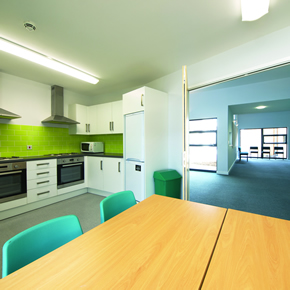
How good design in mainstream schools can support autistic children
Children with autism have a range of particular needs when it comes to the ideal learning environment, and these are unlikely to be provided for by standard classroom design.
The Government’s current drive to bring school provision for children with autism into mainstream schooling raises questions over whether the environments they are expected to be taught in will be appropriate. Martin Peat, director at Richardson & Peat, discusses…
Having been involved in several design and construction contracts to create classrooms for autistic children in mainstream schools, Richardson & Peat has become a specialist in the area. In its experience, using existing classrooms has created difficulties for both students due to the everyday challenges posed by autism.
Unfortunately, in many schools, second-grade portable buildings long past their use by date have been allocated to provide for an intake of children with autism and, in some cases, children and staff have even had to use redundant spaces like old lobby areas and cupboards.
The drive to allow children with autism to grow and develop within a normal school environment is to be applauded. However, it needs to be accompanied by a commitment to providing spaces which are worthy of the commitment being made to their education.
Richardson & Peat has found that, when designing for autistic children, there is a need to assess the level of severity before jumping to a conclusion that the rooms need to be of a highly secure nature. Children being bought into a normal school environment are expected to take part in general school activities at different stages of the day so it is important to design to a level that is robust enough without going over the top.
Working within a moderate budget does not mean the design needs to be compromised, but it does need to be thought through.
Richardson & Peat has identified seven key areas to consider when aiming to create learning spaces which support autistic children:
Flexible space:
Teaching tends to take place either in small groups or on a one-to-one basis so sub-dividing rooms using partitions allows staff to create different areas depending on the requirements of the pupils needing to use them at that time.
It is better to choose movable furniture so the layout can be readily changed, as opposed to the restricted, all-facing-front design of a standard classroom space.
Break out spaces:
These are critical for diffusing challenging situations with pupils; staff are able to see when a child is finding a situation uncomfortable and, being able to move that child into a nearby, non-intimidating space can reduce the chance of confrontation and other children getting involved.
Also, a quiet area or room can work for both the children and staff – many schools pay close attention to children’s needs at the expense of staff that are often under stress and sometimes need a space to regain composure or just relax for five minutes. The inclusion of a teaching kitchen and an exercise area would complete the ideal range of spaces.
Wider corridors:
An element that has become central to our designs is opening corridor areas up into larger spaces for uses beyond just access to include desk space or for a small group meeting area.
This more open layout has the benefit of giving students a clear sight-line to classrooms making them feel more comfortable and less intimidated, providing a lighter feel to what is typically a building’s central core. This can be further enhanced by substituting curves for right angled corners.
Providing a focal point:
Entrance areas provide a focal point for the children; a good reception space is essential to allow them time to settle down and feel reassured before the day begins. It also provides parents with a dropping-in point and an opportunity for an informal chat with a staff member if required.
With a slight expansion on a standard design, entrances can be transformed to provide important and useful spaces for autistic pupils.
Natural light:
Most teachers will agree that natural light is essential, but a general rule with autism is that windows offering too much visual stimulation can be a distraction. High level windows and rooflights go a long way to helping achieve good natural light levels.
Richardson & Peat has found that creating high ceilings, in particular sloping to the shape of the roof and adding rooflights enables natural light to work well throughout the space, giving a fresh feel to the environment.
Acoustics:
Classrooms need to have good sound absorption and reverberation. Acoustic ceiling tiles provide a high level of performance, as do walls designed to achieve the required acoustic levels for specialist teaching. Robust details for wall construction also help with sound and impact.
To create a calming influence within the building the colour palette for internal finishes is one of the most critical areas that need to be addressed. After experimenting with various colour schemes, we have settled on a combination of pastel colours plus a feature wall with a bolder contrasting colour.
Although still subtle, this contrast can help to highlight the layout of the building for pupils. There has been much research into beneficial colours and finishes for children with autism, and we have a general policy to include colours that are non-intimidating yet interesting enough to give the spaces character.
Enlivening exteriors:
If planning is in agreement, greater definition of the external appearance of a classroom or area of a school can not only add character but can also help students focus on where they need to go when starting the school day.
Richardson & Peat has found by using various external treatments such as timber, render and composite coloured panels, entrances can be brought to life and give students a positive entry point to the building, reducing confusion, especially when arriving with all the other school pupils each morning.
Bearing all of these success factors in mind, one question stands out: if we take on board the points mentioned as being a way to achieve a better teaching space for children with autism, and we accept that construction costs must stay within standard school budgets, then why are more classrooms not being built along these lines?
What is good for teaching children who see the world slightly differently must be at least as good for everyone else and, if we accept this then there would be no need for specialist classrooms – they would all just be classrooms.
Find out more in the APRIL ISSUE of PSB MAGAZINE
Latest news

24th April 2024
The lowdown on Origin’s New Soho Offering
Origin’s Soho External Door is the first launch in its new generation of products, setting a higher standard for the fenestration industry.
Posted in Access Control & Door Entry Systems, Aluminium Products, Architectural Ironmongery, Articles, Building Industry News, Building Products & Structures, Building Systems, Doors, Innovations & New Products, Posts, Restoration & Refurbishment, Retrofit & Renovation, Security and Fire Protection
24th April 2024
Mitsubishi Electric welcomes new code of conduct for smart appliances
Mitsubishi Electric welcomes a new code of conduct on energy smart appliances which the European Union (EU) announced yesterday at the Hannover Fair in Germany.
Posted in Air Conditioning, Articles, Building Industry Events, Building Industry News, Building Products & Structures, Building Regulations & Accreditations, Building Services, Exhibitions and Conferences, Facility Management & Building Services, Heating Systems, Controls and Management, Heating, Ventilation and Air Conditioning - HVAC, Plumbing, Retrofit & Renovation, Seminars, Sustainability & Energy Efficiency
24th April 2024
Hamworthy Heating expands CIBSE approved CPD modules with new hot water series
Hamworthy Heating, technical experts in commercial heating and hot water products, announce the expansion of its market leading CIBSE approved Continuing Professional Development (CPD) portfolio with the launch of three new learning modules.
Posted in Articles, Building Industry Events, Building Industry News, Building Products & Structures, Building Services, Continuing Professional Development (CPD's), Facility Management & Building Services, Heating Systems, Controls and Management, Heating, Ventilation and Air Conditioning - HVAC, Plumbing, Retrofit & Renovation, Seminars, Training
24th April 2024
New technology partnership brings Passivent ventilation products to IESVE
Passivent has partnered with Integrated Environmental Solutions (IES) to make a number of its products available to model within the Virtual Environment (VE) platform IESVE.
Posted in Air Conditioning, Articles, Building Industry News, Building Products & Structures, Building Services, Facility Management & Building Services, Heating, Ventilation and Air Conditioning - HVAC, Information Technology, Innovations & New Products, Posts, Retrofit & Renovation, Roofs, Ventilation
 Sign up:
Sign up: